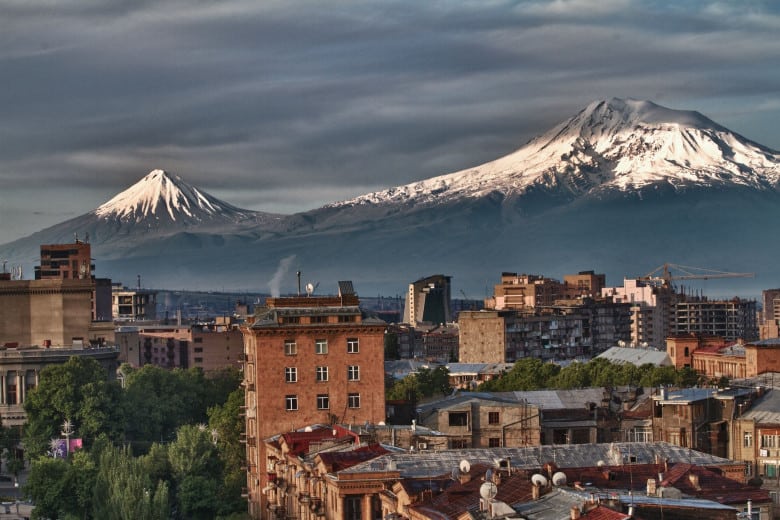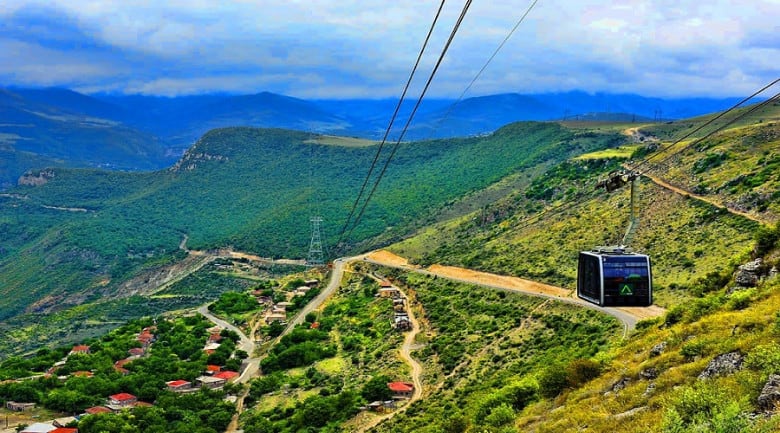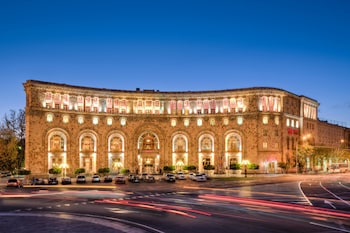The following facts about Armenia will help you visualize Armenia's vibrant past and present. What makes this country stand out above other places? Why does this small nation have such persistent pride? How has this country made such a great contribution to the world around it? Who are the Armenian people and where do they come from? Let us start from the beginning:
- Armenia lies in the highlands of the Southern Caucasus Mountains. There is evidence that civilization existed here since 4000 BC.
- The apricot is Armenia's national fruit. Apricot seeds have been found in the earliest archeological sites. Some early botanical names for apricots are Prunus armeniaca and Mala armeniaca.
- The pomegranate is the Armenian symbol of life. Tradition tells us that a mature pomegranate has 365 seeds, one for each day of the year. The pomegranate appears in artwork, carpets, and design patterns.

- The Armens mixed with the indigenous Hayasa eventually producing the Armenian people. To this day, the Armenian people call themselves "Hay", their country "Hayastan" and their language "Hayeren".
- Recently, the world's oldest known leather shoe, dated at 5500 years old, was discovered in Southern Armenia. Also, a wine-producing facility was found nearby.
- Throughout its history, Armenia has experienced periods of independence and autonomy and been subjected to various empires. At its peak, Armenia was over ten times its present size.
- Yerevan is one of the world's oldest continuously inhabited cities. The fortress of Erebuni (Yerevan) was built in 782 BC, 29 years before the building began in Rome.
- The Armenian Apostolic Church was founded by two of Jesus' apostles: Thaddaeus and Bartholomew. They preached Christianity in Armenia between AD 40–60. In AD 301, Armenia became the first nation to adopt Christianity as a state religion. Today, over 93% of Armenian Christians belong to this church.
- Etchmiadzin is the first cathedral built in ancient Armenia. It is considered the oldest in the world according to scholars.

- In the 5th century, Mesrop Mashtots created a truly unique alphabet for the Armenian language. This new alphabet was created for the purpose of translating the Bible into Armenian. This gave the common person access to the Bible.
- The old Armenian calendar used the base AD 552 on the Julian calendar for year one. This was the date that the Armenian Apostolic Church separated from the Chaledonian Churches. Their new calendar had 12 months of 30 days and an extra month to make up the difference. Each month was given a name and each day a separate name.
- The Armenian eternity sign is a national symbol and identity of the people. It is one of the most common symbols in their architecture, carved on khachkars and on walls of churches.

- Today, due to the Armenian Genocide, most Armenians are living outside of their homeland. Three million Armenians live in Armenia, while seven million are living elsewhere in the world.
- Through the Middle Ages Armenia became weaker due to invading forces. By the 16th century, the Ottoman Empire controlled Western Armenia and the Persian Empire controlled Eastern Armenia. To this day, Western Armenia remains in Turkey.
- The Russian Empire gained control of Eastern Armenia by 1828, following their victory in the Russo-Persian War. This control lasted until the Russian Revolution.
- During the latter days of the Ottoman Empire, Christian Armenians were subjected to extensive discrimination. The Hamidian massacres occurred between 1894-1896. The Armenian Revolutionary Federation began advocating reform and defending villages, thus subjecting them to further massacres.
- On 24 April 1915 Armenian intellectuals and community leaders were rounded up and eventually murdered. This is the date that Armenians commemorate Armenian Genocide Day. Eventually, 1.5 million Armenians lost their lives.
- Mount Ararat is also a national symbol that is sacred to Armenians. Although the peaks are in present-day Turkey, they are most easily seen from Yerevan.

- The Russian Caucasus Army along with Armenian volunteer units and Armenian militia eventually regained most of Western Armenia. These gains were quickly lost due to the Bolshevik Revolution of 1917.
- During the chaos in Russia, Eastern Armenia declared its independence on 28 May 1918. They call this First Republic of Armenia Day, which is still celebrated. Armenian independence was brief--they became part of the Soviet Union on 4 March 1922.
- Following WWII and Stalin's death in 1953, Armenia experienced rapid improvements. Armenian SSR went from a mostly agricultural center to an important industrial production center. Armenia underwent a cultural and economic rebirth which included limited religious freedom. The huge statue of Stalin in Yerevan was replaced with Mother Armenia which still stands over the city.
- Armenia declared its sovereignty from the Soviet Union in 1991. The referendum that followed was overwhelming in favor of full independence, which was declared on 21 September 1991.
- Armenian buildings are constructed mainly of basalt or tuff. The most common variety of tuff used in Armenia has a pinkish color. Since most buildings in Yerevan have tuff exteriors, the city is called "the pink city".
- Armenia's Lake Sevan is one of the largest freshwater high-altitude lakes in Eurasia.

- Armenia has the most chess grandmasters per capita than any other country. Today, chess is part of the curriculum in all public schools.
- The Wings of Tatev cableway is in the Guinness World Record for the longest non-stop reversible aerial tramway. The cableway carries passengers from Halidzor to the Tatev monastery.

- Armenia is the third most mono-ethnic country in the world.
- There are six UNESCO World Heritage Sites in Armenia: Haghpat monastery, Sanahin Monastery, Echmiadzin cathedral and churches, Zvartnots archaeological site, Geghard monastery, and Azat valley.
- Each year in late March to August, about 650 pairs of white storks descend onto wetland-adjacent villages in Armenia. Many of their very large nests are sitting atop electrical poles, visible from the road.
- Armenia has a total of 359 species of birds, of which 14 are rare in Armenia and are not included in the species count.
- The favorite sports played in Armenian are wrestling, weightlifting, judo, association football, chess, and boxing.
Now that you know a little bit about Armenia, why not visit this nation and discover its uniqueness for yourself. The facts and figures do little justice to this nation—it's the warmth of the people that bring everything alive. You'll want to visit Armenia again and again.

Published June 5, 2018
Article by George Casparian





